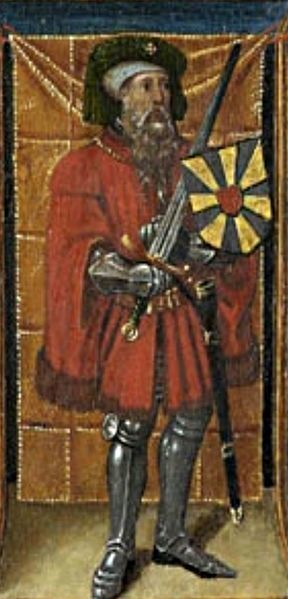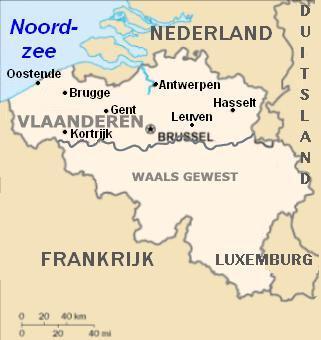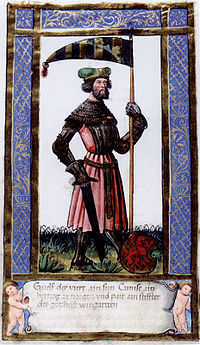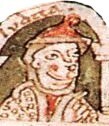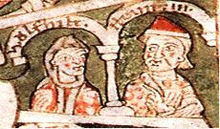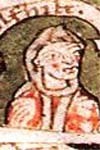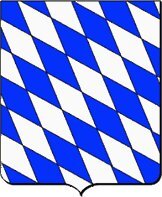maximum test » Henry "Heinrich 'the Black" de Baviera (± 1074-1126)
Persoonlijke gegevens Henry "Heinrich 'the Black" de Baviera
Bron 1- Roepnaam is Heinrich 'the Black.
- Hij is geboren rond 1074 in Bavaria.
- Beroepen:
- Duc, de Bavière, de Spolète.
- Duque da Bavária.
- Hij is overleden op 13 december 1126 in Ravensburg, Donau, Wuerttemberg, Duitsland.
- Hij is begraven in het jaar 1126 in Weingarten, Baden-Württemberg, Duitsland.
- Een kind van Welf en Judith of Flanders
Gezin van Henry "Heinrich 'the Black" de Baviera
Hij heeft/had een relatie met Wulfhilda.
Kind(eren):
Notities over Henry "Heinrich 'the Black" de Baviera
Name Prefix:Emperor Name Suffix: III, of the HRE "The Black"
Henry IX, Duke of Bavaria
From Wikipedia, the free encyclopedia
Henry IX (died 13 December 1126), called the Black(Schulzbacher), a member of the House of Welf, was duke of Bavaria from 1120 to 1126.
Henry was the second son of Welf I, Duke of Bavaria. As a young man, he administered the family's property south of the Alps. Through his marriage to Wulfhild, daughter of Magnus, Duke of Saxony, he acquired part of the Billung property in Saxony.
In 1116, he joined Emperor Henry V's Italian campaign. He succeeded his brother Welf II, Duke of Bavaria, when the latter died childless in 1120.
In the royal election of 1125, he supported his son-in-law Frederick II, Duke of Swabia, but switched his allegiance to Lothair, Duke of Saxony, after Lothair promised that Gertrud, his only daughter and heir, would marry Henry's son Henry.
After Lothair won the election and banned Frederick, in 1126 Henry abdicated as duke of Bavaria and retired to the family foundation of Weingarten Abbey so that he did not have to take part in the prosecution of his son-in-law. Henry died shortly thereafter and was buried in Weingarten.
Henry had the following children:
Judith, married Frederick II, Duke of Swabia
Conrad, died 17 March 1126
Henry X the Proud
Welf
Sophia, married Berthold III, Duke of Zähringen and Leopold I, Duke of Styria
Wulfhild, married Rudolf, Count of Bregenz
Mathilde, married Diepold IV, Margrave of Vohburg and Gebhard III, Count of Sulzbach
Adalbert, Abbot of Corvey
Preceded by:
Welf II Duke of Bavaria
1120-1126 Succeeded by:
Henry X
[alfred_descendants10gen_fromrootsweb_bartont.FTW]
Duke of Bavaria; m. WULFHILDA. (Weis 106-24).
Note: I (Jim Weber) make Henry the "IX"th Duke of Bavaria (as does the Encyclopaedia Britannica). Turton also names him Henry I, while adding Saxony to his Ducal title; therefore he is probably Henry I Duke of Saxony and IX Duke of Bavaria. This supposition is indirectly confirmed by the Encyclopaedia Britannica, which names his son Henry X of Bavaria and Henry II of Saxony. (AR is incorrect in naming him Henry I of Bavaria).
He suceeded his brother Guelph as duke in 1120. He was one of the med iators in the settlement of hte long struggle over investitures. Afte r the death of Calixtus II, he supported Frederick of Hohenstauffen fo r Emperor.
(ref: http://en.wikipedia.org/wiki/Henry_IX%2C_Duke_of_Bavaria) HenryI X (died 13 December 1126), called the Black(Schulzbacher), a member o f the House of Welf, was duke of Bavaria from 1120 to 1126.
Henry was the second son of Welf I, Duke of Bavaria. As a young man, h e administered the family's property south of the Alps. Through his ma rriage to Wulfhild, daughter of Magnus, Duke of Saxony, he acquired pa rt of the Billung property in Saxony.
In 1116, he joined Emperor Henry V's Italian campaign. He succeeded hi s brother Welf II, Duke of Bavaria, when the latter died childless in1 120. In the royal election of 1125, he supported his son-in-law Frede rick II, Duke of Swabia, but switched his allegiance to Lothair, Duke of Saxony, after Lothair promised that Gertrud, his only daughter and heir, would marry Henry's son Henry.
After Lothair won the election and banned Frederick, in 1126 Henry abd icated as duke of Bavaria and retired to the family foundation of Wein garten Abbey so that he did not have to take part in the prosecution o f his son-in-law. Henry died shortly thereafter and was buried in Wein garten.
Henry had the following children: 1.) Judith, married Frederick II, Du ke of Swabia; 2.) Conrad, died 17 March 1126; 3.) Henry X the Proud; 4 .) Welf; 5.) Sophia, married Berthold III, Duke of Zähringen and Leopo ld I, Duke of Styria; 6.) Wulfhild, married Rudolf, Count of Bregenz;7 .) Mathilde, married Diepold IV, Margrave of Vohburg and Gebhard III, Count of Sulzbach; and 8.) Adalbert, Abbot of Corvey
{geni:about_me} Welfe der jüngeren schwäbischen Linie
https://en.wikipedia.org/wiki/Henry_IX,_Duke_of_Bavaria
http://genealogics.org/getperson.php?personID=I00020369&tree=LEO
http://fmg.ac/Projects/MedLands/BAVARIA.htm#HeinrichXBavariadied1139B
HEINRICH, son of WELF I Duke of Bavaria & his second wife Judith de Flandre ([1074]-Ravensburg 13 Dec 1126, bur Weingarten). The Annalista Saxo records the death in 1126 of "Heinricus dux Bawarie…filius Welphonis ducis…[et] Iudhitam"[335]. On the death of his father-in-law in 1106, he inherited extensive territories in Saxony around Lüneburg and in the Bardengau[336]. He was appointed to succeed his brother in 1120 as HEINRICH IX "der Schwarze" Duke of Bavaria. He initially supported the candidacy of his son-in-law Friedrich Duke of Swabia to succeed Emperor Heinrich V as King of Duitsland in 1125, but eventually supported the election of Lothar von Süpplingenberg, presumably on the understanding of his son's marriage to Lothar's only daughter, which took place in 1127[337]. The enmity of the Staufen family which this created was to have far-reaching consequences in Duitsland for the rest of the century. Duke Heinrich became a monk at Weingarten shortly before his death[338]. The Historia Welforum records that Duke Heinrich became a monk shortly before he died "in castro Ravenspurch"[339]. The necrology of Lüneburg records the death "12 Dec" of "Henricus dux"[340]. The necrology of Weingarten records the death "Id Dec" of "Heinricus dux et m n c …pater Welfonis, hic sepultus"[341].
m WULFHILD of Saxony, daughter of MAGNUS Duke of Saxony [Billung] & his wife Sofia of Hungary (-Altdorf 29 Dec 1126, bur Weingarten). The Annalista Saxo names "Wifhildem et Eilicam" as the two daughters of Duke Magnus & his wife,specifying that Wulfhild married "Heinrico duci, filio Welfi ducis senioris de Bawaria"[342]. The Historia Welforum records that Wulfhild died at Altdorf "decimo sexton die post mortem mariti" and was buried "in monasterio sancti Martini"[343]. The necrology of Lüneburg records the death "29 Dec" of "Wlfhild ducissa"[344]. The necrology of Weingarten records the death "IV Kal Jan" of "Wuolfhildis ducissa hic sepulta"[345].
Mistress (1): ---. The name of Duke Heinrich's mistress is not known.
Duke Heinrich & his wife had seven children:
1. HEINRICH ([1108]-Quedlinburg 20 Oct 1139, bur Königslutter). The Annalista Saxo names "Heinricum inclitum ducem Saxonie et Bawarie et Welfonem et quatuor filias" as children of Duke Heinrich & his wife Wulfhild[346]. He succeeded his father in 1126 as HEINRICH X "der Stolze" Duke of Bavaria. His father-in-law installed him as administrator of the lands previously held by Matilda of Tuscany, after conceding papal ownership of them in return for a usufruct[347]. His father-in-law invested him as HEINRICH Duke of Saxony in 1137 shortly before his death.
a) HEINRICH ([1132/33]-Braunschweig 6 Aug 1195, bur Braunschweig Cathedral). He succeeded in 1142 as HEINRICH "der Löwe" Duke of Saxony, and in 1156 as HEINRICH XII Duke of Bavaria. He lost Saxony and Bavaria 1180, but kept his territories in Braunschweig.
- DUKES of SAXONY.
2. KONRAD (-Bari 17 Mar 1126, bur Molfetta). The Historia Welforum names (in order) "Counradum, Heinricum, Guelfonem" as the three sons of "Heinricus dux ex Wulfilde", specifying that Konrad "in clericum ordinatus" and became a monk at "Clarevallense monasterium", visited Jerusalem, and died on his return journey at Bari where he was buried[348]. Cistercian monk.
3. SOPHIE (-10 Jul before 1147). The Historia Welforum names (in order) "Iuditham, Sophiam, Mahtildem, Wulfildem" as the four daughters of "Heinricus dux ex Wulfilde", specifying that Sophie married firstly "Bertoldusdux de Zaringen" and secondly "Leopaldus marchio de Stira"[349]. The Annalista Saxo names "Heinricum inclitum ducem Saxonie et Bawarie et Welfonem et quatuor filias" children of Duke Heinrich & his wife Wulfhild, specifying thatSophie (named second in the list of daughters) married firstly "Bertoldus dux de Zaringe" and secondly "marchio Liuppoldus de Stire"[350]. The Genealogia Zaringorum names "Sophya soror Heinrici ducis Saxonie" as wife of "Berchtoldus", specifying that they were childless and that she married secondly "comiti de Stire"[351]. She became a nun at Admont after her second husband died. The necrology of Admunt records the death "VI Id Jul" of "Sophya ex marchionissa cv"[352]. The necrology of Weingarten records the death "V Id Jul" of "Suophia com de Stira hic sepulta"[353].
m firstly BERTHOLD III Herzog von Zähringen, son of BERTHOLD II Herzog von Zähringen [Baden] & his wife Agnes von Rheinfelden (-killed in battle near Molsheim 3 Dec 1122, bur St Peter im Schwarzwald).
m secondly ([1122/23]) LEOPOLD “der Starke” Markgraf of Styria, son of OTAKAR II Markgraf of Styria & his wife Elisabeth of Austria [Babenberg] (-24 Oct 1129).
4. JUDITH (after 1100-22 Feb [1130/31], bur Walburg im Heiligen Forst, Alsace). The Historia Welforum names (in order) "Iuditham, Sophiam, Mahtildem, Wulfildem" as the four daughters of "Heinricus dux ex Wulfilde", specifying that Judith married "Friderico Suevorum duci"[354]. The Annalista Saxo names "Heinricum inclitum ducem Saxonie et Bawarie et Welfonem et quatuor filias" as children of Duke Heinrich & his wife Wulfhild, specifying that one of the daughters (mentioned first in the list of daughters, but not named) married "Fridericus dux Suevorum"[355].
m ([1119/21]) as his first wife, FRIEDRICH II “der Einäugige” Duke of Swabia, son of FRIEDRICH I Duke of Swabia [Staufen] & his wife Agnes of Duitsland (1090-Alzey 4 or 6 Apr 1147, bur Walburg Abbey).
5. MATHILDE (-16 Feb or 16 Mar [1183], bur Kastl). The Historia Welforum names (in order) "Iuditham, Sophiam, Mahtildem, Wulfildem" as the four daughters of "Heinricus dux ex Wulfilde", specifying that Mathilde married firstly "Theopaldo filio Theopaldi marchionis de Voheburch" and secondly "Gebehardo de Sulzbach"[356]. The Annalista Saxo names "Heinricum inclitum ducem Saxonie et Bawarie et Welfonem et quatuor filias" as children of Duke Heinrich & his wife Wulfhild, specifying that "Quarta Machtildis nomine" married firstly "Thieppoldo iuniori, filio Thieppoldi marchionis senioris" and secondly "Gebehardus filius Beringeri comitis de Sulzbach"[357].
m firstly ([1128]) DIEPOLD [IV] Markgraf von Vohburg, son of DIEPOLD [III] von Giengen Markgraf von Vohburg & his first wife Adelajda of Poland (-[1128]).
m secondly (contract 24 Oct 1129) GEBHARD [III] Graf von Sulzbach, son of BERENGAR [I] Graf von Sulzbach & his second wife Adelheid von Wolfratshausen [Diessen] (-28 Oct [1188], bur Kastl).
6. WELF [VI] ([16 Dec 1114/15 Dec 1116]-Memmingen 14/15 Dec 1191, bur Steingaden). The Annalista Saxo names "Heinricum inclitum ducem Saxonie et Bawarie et Welfonem et quatuor filias" as the children of Duke Heinrich & his wife Wulfhild[358]. The Historia Welforum names (in order) "Counradum, Heinricum, Guelfonem" as the three sons of "Heinricus dux ex Wulfilde"[359]. After the death of his older brother Heinrich in 1139, Welf led the opposition to Konrad III King of Duitsland in Bavaria, although he was defeated at Weinsberg in 1140[360]. He founded Kloster Steingaden in 1147. He joined the Second Crusade with King Konrad in 1147, and took part in the 25 Oct 1147 defeat at Dorylaeum[361]. When King Konrad agreed an alliance with Emperor Manuel I against Roger II King of Sicily, Welf agreed to support the Sicilians[362]. Welf was heavily defeated at Flochberg near Nördlingen in Feb 1150 andreached a peace settlement with King Konrad in 1151[363]. In 1152, Frederick I "Barbarossa" King of Duitsland invested Welf as Duke of Spoleto and Marchese of Tuscany, and with Sardinia and the lands formerly held by Matilda Ctss of Tuscany, as a means of acquiring Welf support after his election[364]. Vogt von Zwiefalten 1152. Von Ravensburg 1152. Short of money, Welf gradually returned his Italian lands to Emperor Friedrich I, and from 1173 ceased to use his Italian titles. Welf VI also agreed to make Emperor Friedrich his successor in the Welf lands around Ravensburg[365]. The necrology of Raitenbuch records the death "XIX Kal Jan" of "dux Guelfo VI fundator monasterii Staingadensis"[366]. The necrology of Weingarten records the death "XVIII Kal Jan" of "Welfo dux, Welfonum ultimus filius Heinrici ducis"[367]. m (before Jan 1133) UTA von Calw Herzogin von Schauenburg, daughter of GOTTFRIED I Graf von Calw Pfalzgraf am Rhein & his wife Liutgard von Zähringen (-1196). The Annales Sindelfingenses name (in order) "Uotam [uxorem Welphoni de Spoleto] et Lutgardam" as daughters of "Uotæ"[368]. The Historia Welforum names "filiam Gotefridi…palatine de Kalwe, Outam" as wife of "Guelfo…frater…Heinrico duce"[369]. She founded Kloster Allerheiligen in 1192. Duke Welf & his wife had one child:
a) WELF [VII] (-Siena 12 Sep 1167, bur Steingaden). The Annales Sindelfingenses name "Welphonem iuniorem" as son of "Welphoni de Spoleto" and his wife Uta, specifying that he besieged Tübingen "1165 VIII Id Sep"[370].Duke of Spoleto 1160. He died of malaria while fighting on Emperor Friedrich I's Italian expedition of 1167[371]. The Hugonis Ratisponensis Cronica records the death in 1167 of "Welfo filius Welfonis" during the emperor's Italian campaign[372]. The necrology of Weingarten records the death "II Id Sep" of "Welf dux iunior"[373].
7. WULFHILD (-18 May after 1156). The Historia Welforum names (in order) "Iuditham, Sophiam, Mahtildem, Wulfildem" as the four daughters of "Heinricus dux ex Wulfilde", specifying that Wulfhild married "Roudolfus Bregantinus comes"[374]. The Annalista Saxo names "Heinricum inclitum ducem Saxonie et Bawarie et Welfonem et quatuor filias" as the children of Duke Heinrich and his wife Wulfhild, specifying that "terciam nominee Wifhildem" married"Rodolfus comes de Bregence"[375]. Nun at Wessobrunn 1155.
m as his second wife, RUDOLF Graf von Bregenz, son of ULRICH [X] Graf von Bregenz & his wife Bertha von Rheinfelden (-27/28 Apr 1160).
Duke Heinrich had one illegitimate child by Mistress (1):
8. ADALBERT (-1144). Abbot of Corvey. The Annalista Saxo records that "Adalbero frater Heinrici ducis" succeeded as Abbot of Corvey in 1138[376]. It is assumed that "Heinrici ducis" refers to Heinrich X [Welf] who was duke of Bavaria and Saxony at that date. Adalbert is unlikely to have been the legitimate son of Duke Heinrich IX as he is not named as such in other sources (see above) which appear to provide an exclusive list of the duke'schildren by his wife Wulfhild.
--------------------
Heinrich IX Herzog von Bayern (1)
M, #7962, b. circa 1074, d. 13 December 1126
Last Edited=15 Jul 2005
Consanguinity Index=0.02%
Heinrich IX Herzog von Bayern was born circa 1074. He was the son of Guelph IV Herzog von Bayern and Judith de Flandre. (1) He married Wolfhildis von Sachsen, daughter of Magnus I Herzog von Sachsen and Sophia of Hungary, between 1095 and 1100.
He died on 13 December 1126.
Heinrich IX Herzog von Bayern also went by the nick-name of Heinrich 'the Black'. (1) He gained the title of Herzog von Sachsen auf der Elbe. He succeeded to the title of Herzog von Bayern in 1120. (1)
Children of Heinrich IX Herzog von Bayern and Wolfhildis von Sachsen
-1. Conrad von Bayern d. 17 Mar 1126
-2. Maud von Bayern d. 16 Mar 1183
-3. Wolfhilde von Bayern d. a 1160
-4. Judith von Bayern+ b. c 1100, d. a 1130
-5. Heinrich X Herzog von Bayern+ b. c 1102, d. 20 Oct 1139
-6. Guelph VI von Bayern, Duca di Spoleto+ b. c 1115, d. 15 Dec 1191
-7. Sophie von Bayern b. b 1126, d. 11 Jul 1145
--------------------
Wikipedia:
Heinrich IX. (Bayern)
aus Wikipedia, der freien Enzyklopädie
Wechseln zu: Navigation, Suche
Heinrich mit Wulfhild in der Historia Welforum
Heinrich der Schwarze (* 1075; † 13. Dezember 1126 in Ravensburg) war als "Heinrich IX." Herzog von Bayern. Er kam aus dem Haus der Welfen und war ein Sohn Welfs IV. und Bruder Welfs V., nach dessen nachfolgerlosem Tode er 1120 das Herzogtum Bayern übernahm.
Durch seine Ehe mit Wulfhild Billung, der Tochter des letzten Sachsenherzogs Magnus aus dem Hause der Billunger, erlangten die Welfen Besitzungen in Norddeutschland. Die Ehe seiner Tochter Judith mit dem staufischen Herzog Friedrich II. von Schwaben legte den Grundstein für die späteren welfisch-staufischen Konflikte.
Eine besondere Rolle spielte Heinrich der Schwarze bei der Königswahl von 1125. Zunächst förderte er die Kandidatur seines Schwiegersohnes Friedrich II. von Schwaben. Kurz vor dem entscheidenden Wahlgang änderte er jedoch seine Meinung und stimmte für den anderen Kandidaten Herzog Lothar von Sachsen, der dadurch als Lothar III. zum deutschen König gewählt wurde. Diese Meinungsänderung wurde offensichtlich ausgelöst durch das Heiratsversprechen von Lothars Tochter Gertrud mit Heinrichs Sohn Heinrich (der Stolze), das 1127 eingelöst wurde. Die verprellten Staufer riefen danach Friedrichs jüngeren Bruder Konrad zum Gegenkönig aus. Der welfisch-staufische Konflikt nahm seinen Lauf.
Familie [Bearbeiten]
Aus der zwischen 1095 und 1100 geschlossenen Ehe mit Wulfhild Billung von Sachsen gingen sieben Kinder hervor:
* Heinrich der Stolze († 1139), Herzog von Bayern und Sachsen
* Konrad († 1154), Zisterziensermönch
* Judith (* nach 1100, † 1130/31) – verheiratet um 1121 mit Friedrich II., Herzog von Schwaben
* Sophie († um 1145) – verheiratet mit 1. Berthold III. von Zähringen und 2. Markgraf Leopold von Steyr.
* Mathilde, († 1183) – verheiratet mit 1. Markgraf Diepold IV. von Vohburg (Rapotonen) und 2. Graf Gebhard III. von Sulzbach
* Welf VI. (* 1115/16, † 1191), Herzog von Spoleto
* Wulfhild († nach 1160) – verheiratet mit Rudolf Graf von Bregenz
Literatur [Bearbeiten]
* Sigmund Ritter von Riezler: Heinrich IX.. In: Allgemeine Deutsche Biographie (ADB). Band 11. Duncker & Humblot, Leipzig 1880, S. 461 f.
* Kurt Reindel: Heinrich IX. der Schwarze. In: Neue Deutsche Biographie (NDB). Band 8. Duncker & Humblot, Berlin 1969, S. 343.
Weblinks [Bearbeiten]
* genealogie-mittelalter.de
* Urkunde Heinrichs IX für Kloster Ranshofen, 30. Juli 1125 als Fotografie in den Beständen des Lichtbildarchivs älterer Originalurkunden an der Philipps-Universität Marburg mit Wiedergabe der herzoglichen Siegels.
Vorgänger
Welf II.
Herzog von Bayern
1120–1126 Nachfolger
--------------------
--------------------
Henry IX, Duke of Bavaria
From Wikipedia, the free encyclopedia
Henry IX (died 13 December 1126), called the Black, a member of the House of Welf, was duke of Bavaria from 1120 to 1126.
Henry was the second son of Welf I, Duke of Bavaria and Judith of Flanders. As a young man, he administered the family's property south of the Alps. Through his marriage to Wulfhild, daughter of Magnus, Duke of Saxony, he acquiredpart of the Billung property in Saxony.
In 1116, he joined Emperor Henry V's Italian campaign. He succeeded his brother Welf II, Duke of Bavaria, when the latter died childless in 1120.
In the royal election of 1125, he supported his son-in-law Frederick II, Duke of Swabia, but switched his allegiance to Lothair, Duke of Saxony, after Lothair promised that Gertrud, his only daughter and heir, would marry Henry's son Henry.
After Lothair won the election and banned Frederick, in 1126 Henry abdicated as duke of Bavaria and retired to the family foundation of Weingarten Abbey so that he did not have to take part in the prosecution of his son-in-law. Henry died shortly thereafter and was buried in Weingarten.
Henry and Wulfhild had the following children:
Judith, married Frederick II, Duke of Swabia
Conrad, died 17 March 1126
Henry X the Proud
Welf
Sophia, married Berthold III, Duke of Zähringen and Leopold I, Duke of Styria
Wulfhild, married Rudolf, Count of Bregenz
Mathilde, married Diepold IV, Margrave of Vohburg and Gebhard III, Count of Sulzbach
Adalbert, Abbot of Corvey
--------------------
Henry IX (died 13 December 1126), called the Black, a member of the House of Welf, was duke of Bavaria from 1120 to 1126.
Henry was the second son of Welf I, Duke of Bavaria and Judith of Flanders. As a young man, he administered the family's property south of the Alps. Through his marriage to Wulfhild, daughter of Magnus, Duke of Saxony, he acquiredpart of the Billung property in Saxony.
In 1116, he joined Emperor Henry V's Italian campaign. He succeeded his brother Welf II, Duke of Bavaria, when the latter died childless in 1120.
In the royal election of 1125, he supported his son-in-law Frederick II, Duke of Swabia, but switched his allegiance to Lothair, Duke of Saxony, after Lothair promised that Gertrud, his only daughter and heir, would marry Henry's son Henry.
After Lothair won the election and banned Frederick, in 1126 Henry abdicated as duke of Bavaria and retired to the family foundation of Weingarten Abbey so that he did not have to take part in the prosecution of his son-in-law. Henry died shortly thereafter and was buried in Weingarten.
Henry and Wulfhild had the following children:
Judith, married Frederick II, Duke of Swabia
Conrad, died 17 March 1126
Henry X the Proud
Welf
Sophia, married Berthold III, Duke of Zähringen and Leopold I, Duke of Styria
Wulfhild, married Rudolf, Count of Bregenz
Mathilde, married Diepold IV, Margrave of Vohburg and Gebhard III, Count of Sulzbach
Adalbert, Abbot of Corvey
--------------------
Henry IX (died 13 December 1126), called the Black, a member of the House of Welf, was duke of Bavaria from 1120 to 1126.
Henry was the second son of Welf I, Duke of Bavaria and Judith of Flanders. As a young man, he administered the family's property south of the Alps. Through his marriage to Wulfhild, daughter of Magnus, Duke of Saxony, he acquiredpart of the Billung property in Saxony.
In 1116, he joined Emperor Henry V's Italian campaign. He succeeded his brother Welf II, Duke of Bavaria, when the latter died childless in 1120.
In the royal election of 1125, he supported his son-in-law Frederick II, Duke of Swabia, but switched his allegiance to Lothair, Duke of Saxony, after Lothair promised that Gertrud, his only daughter and heir, would marry Henry's son Henry.
After Lothair won the election and banned Frederick, in 1126 Henry abdicated as duke of Bavaria and retired to the family foundation of Weingarten Abbey so that he did not have to take part in the prosecution of his son-in-law. Henry died shortly thereafter and was buried in Weingarten.
Henry and Wulfhild had the following children:
Judith, married Frederick II, Duke of Swabia
Conrad, died 17 March 1126
Henry X the Proud
Welf
Sophia, married Berthold III, Duke of Zähringen and Leopold I, Duke of Styria
Wulfhild, married Rudolf, Count of Bregenz
Mathilde, married Diepold IV, Margrave of Vohburg and Gebhard III, Count of Sulzbach
Adalbert, Abbot of Corvey
--------------------
Henry IX, called "the Black," a member of the House of Welf, was Duke of Bavaria from 1120 to 1126. As a young man, he administered the family's property south of the Alps. Through his marriage to Wulfhild, daughter of Magnus, Duke of Saxony, he acquired part of the Billung property in Saxony.
Henry and Wulfhild had 8 children, including our ancestor Judith.
In 1116, he joined Holy Roman Emperor Henry V's Italian campaign. He succeeded his brother Welf II, Duke of Bavaria, when the latter died childless in 1120.
In the royal election of 1125, he supported his son-in-law Frederick II, Duke of Swabia, but switched his allegiance to Lothair, Duke of Saxony, after Lothair promised that Gertrud, his only daughter and heir, would marry Henry's son Henry.
After Lothair won the election and banned Frederick, in 1126, Henry abdicated as Duke of Bavaria and retired to the family foundation of Weingarten Abbey so that he did not have to take part in the prosecution of his son-in-law. Henry died shortly thereafter and was buried in Weingarten.
--------------------
Henry IX (died 13 December 1126), called the Black, a member of the House of Welf, was duke of Bavaria from 1120 to 1126.
Life and reign
Henry was the second son of Welf I, Duke of Bavaria and Judith of Flanders. As a young man, he administered the family's property south of the Alps. Through his marriage to Wulfhild, daughter of Magnus, Duke of Saxony, he acquiredpart of the Billung property in Saxony.
In 1116, he joined Emperor Henry V's Italian campaign. He succeeded his brother Welf II, Duke of Bavaria, when the latter died childless in 1120.
In the royal election of 1125, he supported his son-in-law Frederick II, Duke of Swabia, but switched his allegiance to Lothair, Duke of Saxony, after Lothair promised that Gertrud, his only daughter and heir, would marry Henry's son Henry.
After Lothair won the election and banned Frederick, in 1126 Henry abdicated as duke of Bavaria and retired to the family foundation of Weingarten Abbey so that he did not have to take part in the prosecution of his son-in-law. Henry died shortly thereafter and was buried in Weingarten.
Henry and Wulfhild had the following children:
Judith, married Frederick II, Duke of Swabia
Conrad, died 17 March 1126
Henry X the Proud
Welf
Sophia, married Berthold III, Duke of Zähringen and Leopold I, Duke of Styria
Wulfhild, married Rudolf, Count of Bregenz
Mathilde, married Diepold IV, Margrave of Vohburg and Gebhard III, Count of Sulzbach
Adalbert, Abbot of Corvey
--------------------
CASA DE BAVIERA (o de WELF)
1) Significado: El origen de la Casa de Baviera o de Welf se remonta a los años oscuros de la Alta Edad Media. El nombre procede del pueblo que habitaba la región sur de Alemania a principios del siglo IV: los Bávaros.
2) Casa solar: Baviera, al sur de Alemania.
3) Armas: Las de la Casa de Baviera, en la Baja Edad Media, son: Escudo fuselado en bandas de azur y plata (Fuselé en bande d'azur et d'argent).
4) Antepasados:
I. Engelberto I von Altdorf nació hacia el año de 640. Murió en el 718. Tuvo por hijo a
II. Isembart I von Altdorf nació hacia el año de 670. Murió el 736. Tuvo por hijo a
III. Engelberto II von Altdorf nació hacia el año de 700. Murió hacia el 772. Casó con una hija de Houching de Alemania (ver nota 1) y Berta de Neustria (ver nota 2). Tuvieron por hijo a
IV. Isembart II von Altdorf nació hacia el año de 745. Murio el 823. Casó con Ermengarda de Francia, hija de Pipino "el Breve", rey de Francia, y Berta, condesa de Laon (ver Carolingios).
V. Welf de Suabia, conde de Andech y Baviera nació hacia el año de 760. Murió en 824. Casó con Heilwig de Sajonia, abadesa de Challes (ver nota 3). Tuvo por hijos a Conrado I de Auxerre, abad de Saint Gall (c.800; ver Reyes de Borgoña), Judith von Altdorf (805, casada con Luis el Piadoso, emperador; ver Dinastía Carolingia), Rodolfo (abad de Saint Riquier, m. 866), Emma von Altdorf (809, casada con Luis "el Germánico", rey de Francia Oriental, de la cual tuvo por hijas a la Beata Ermengarda y a Gisela de Alemania)
VI. Conrado I, conde de Auxerre, abad de Saint Gall nació hacia el año 805. Murió el 25-IV-863. Casó con Adelaida de Tours (hija de Hugo de Tours, conde de Alsacia y Bava de Morvois). Tuvieron cuatro hijos: Petronila (c.825; que entronca con el linaje de Anjou), Conrado II de Auxerre —padre de Rodolfo I, rey de Borgoña (c.835)—, Welf I (c.840; que sigue) y Hugo, Abad de San Martín de Tours (+866).
VII. Welf I im Argengau und Linzgau nació hacia el año 840 en Auxerre, Borgoña. Murió antes del 876. Desconocemos en nombre de su mujer. Tuvo por hijo a
VIII. Ethico im Argengau nació hacia el año 870. Casó con Egila. Tuvo por hijo a
IX. Enrique de Baviera nació hacia el año 900. Casó con Atha von Honenwart. Tuvieron por hijo a
X. Rodolfo I von Altdorf nació hacia el año 930. Tuvo por hijo a
XI. Rodolfo II von Altdorf nació hacia el año 960. Casó con Itha von Öehningen (ver nota 4). Tuvieron por hijo a
XII. Welf II von Altdorf nació hacia el año 990. Murió el 20-VI-1030. Casó con Ermengarda de Luxemburgo (ver nota 5). Tuvieron por hija a
XIII. Cunigunda de Welf nació hacia el año 1020. Murió antes del 1055. Casó con Azzo II, marqués de Este (ver nota 6), hacia 1035. Tuvieron por hijo a
XIV. Welf IV, duque de Baviera nació hacia el año de 1036. Murió el 8-III-1101/02. Tuvo por hijos a Welf V (+1120, y casado con Matilde de Toscana) y a Enrique el Negro, duque de Baviera (c.1074, que sigue).
XV. ENRIQUE "EL NEGRO", DUQUE DE BAVIERA nació hacia el año 1074. Murió el 11-IV-1127. Casó con WULFHILDA DE SAJONIA (ver nota 7). Tuvo por hijos a Enrique el Soberbio, duque de Baviera y Sajonia (casado con Gertrudis, hija del emperador Lotario III; +1139; padres de Enrique el León, duque de Baviera y Sajonia, +1195 y casado con Matilde de Inglaterra), Welf VI (+1191, padre de Welf VII, +1197) y Judith de Baviera (nacida después de 1100, que sigue).
XVI. Judith de Baviera nació hacia el año de 1100. Murió el 20-VI-1132. Casó, en 1121, con Federico, duque de Suabia-Hohenstaufen. Tuvieron por hijo a Federico I, "Barbaroja", emperador de Alemania (1122; ver Casa de Suabia), del cual procede nuestra familia.
NOTAS:
* La Estirpe Welf: ver cuadro genealógico en Historia Universal, EUNSA, tomo IV, p. 297. Desde Welf, conde de Baviera, hasta Rodolfo I, conde en Transjurana, rey de Borgoña (888-912).
[1] Houchin de Alemania nació hacia el año 660. Murió hacia el 727. Casó con Berta de Neustria el 694. Tuvieron dos hijos: Nebi de Alemania (c.705), padre de Imma de Alemania, que casó con Gerold I von Vintzgau y otra hija que casó con Engelberto II von Altdorf. Los padres de Houching fueron Godefried de Alemania (630-709) y Ragnetruda de Baviera (630), que casaron en 657. Abuelos paternos: Lotario II de Alemania (c.600-c-665, hijo de Cuno, nieto de Lutfrido I y biznieto de Lotario I de Alemania, que nació hacia el año 520 y murió el 554) y Wilibalda de Borgoña (c.600, hija de Wilibaldo, patricio de Borgoña, nieta de Alethee de los Burgundios y retataranieta de Wilibaldo, rey de los Burgundios que, según la leyenda, era hijo de Godomar y nieto de Gundobado de los Burgundios). Abuelos maternos: Theodon I de Baviera (616, hijo de Garibaldo II de Baviera y Geila de Friuli: ver Casa Antigua de Baviera) y Regentruda de Austrasia (descendiente de los Reyes Francos).
[2] Berta de Neustria nació hacia el año 676. Murió el 740. Casó con Houching de Alemania el 694. Sus padres fueron Thierry III, rey de Neustria (654 a 4-IX-691, nieto de Dagoberto I: ver Reyes Francos) y Santa Clotilde de Metz (651-699).
[3] Heilwig de Sajonia, abadesa de Challes nació el año 775 y murió el 838. Sus padres fueron Widukin "el Grande", de Sajonia (c.750 a 4-III-809/810, ver Casa de Sajonia) y Svetana de Sajonia, hija de Bernardo y nieta de Carlos Martel (ver Carolingios).
[4] Itha von Öehningen nació hacia el año 965. Murió el 3-XI-1020. Sus padres fueron Cuno I von Öehningen y Richilda de Alemania. Tuvieron por hijas a Judith (c.960, casada con Luis de Dagsbourg), Itha (c.965, casada con Rodolfo II von Altdorf), Richilda (c.975, casada con Cuno de Rheinfelden) y Cunigunda (c.680, casada con Federico von Hohenstaufen: ver Dinastía Hohenstaufen).
[5] Ermengarda de Luxemburgo es descendiente de los primeros señores de la Casa de Luxemburgo, a partir del siglo X, que fueron Ricwin de Verdun (900 a c.923) y Cunigunda de Gante (c.893, que fue hija de Ermentruda de Francia y nieta de Luis II "el Tartamudo" y Adelaida de París: ver Carolingios). Ricwin y Cunigunda tuvieron por hijo a
II. Sigfrido II de Luxemburgo (992 a 8-XI-998), que casó con Hedwig de Alsacia (Nordgau), nacida hacia 937 e hija de Eberhard IV de Alsacia y Liutgarda de Treveris. Tuvieron por hijos a Eva (c.953, casada con Gerardo de Metz), Liutgarda (c.955, casada con Arnulfo de Ostfrisia, de los cuales procede el linaje de los Condes de Holanda) y Federico (c.958, que sigue).
III. Federico I de Luxemburgo (c.958 a 16-I-1019/20), que casó con Ermetruda von Gleiberg, hija de Herbert I von Kinzisgau -nieto de Oda de Sajonia- y Ermentruda de Avelgau, que era hija de Meningoz de Avelgau y Gerberga de Metz, hija, a su vez, de Godofredo de Metz y Ermentruda de Francia, hija de Carlos III el Simple y Frederna de Ringelheim: ver Carolingios). Federico y Ermetruda tuvieron por hijas a Cunegunda de Luxemburgo (c.990 a 8-VI-1030, esposa deBalduino IV "el Barbudo" de Lille: ver Condes de Flandes) y a Ermengarda de Luxemburgo (c.997 a 11-XI-1055, esposa de Welf II von Altdorf).
[6] Azzo II, marqués de Este nació hacia 1018. Murió en 1097. Casó con Cunigunda de Welf hacia 1035. Sus padres fueron Azzo I, conde de Luni, Génova y Milán, y Artopergue. Sus abuelos paternos: Hugo I de Este (c.976 a 1014) y María de Este. Sus bisabuelos paterno paternos: Alberto Azzon II de Este (c.954-995) y Alde von Sachsen. Sus tatarabuelos: Alberto Azzon I de Este (c.912-974) y Ermengarda de Toscana (c.940-987), que era hija de Humberto II de Toscanay nieta de Adalberto I, marqués de Ivrea y Gisela, condesa de Friuli. Ver Casa de Borgoña-Ivrea.
[7] WULFHILDA DE SAJONIA nació en 1071. Murió el 27-IV-1127. Sus padres fueron Magnus I de Sajonia (+22-XII-1106, hijo de Otón de Sajonia y Wulfhid de Noruega) y Sofía de Hungría (1040 a 28-IX-1095).
--------------------
Henry IX, Duke of Bavaria, (died 13 December 1126), called the Black, a member of the House of Welf, was duke of Bavaria from 1120 to 1126.
Henry was the second son of Welf I, Duke of Bavaria and Judith of Flanders. As a young man, he administered the family's property south of the Alps. Through his marriage to Wulfhild, daughter of Magnus, Duke of Saxony, he acquiredpart of the Billung property in Saxony.
In 1116, he joined Emperor Henry V's Italian campaign. He succeeded his brother Welf II, Duke of Bavaria, when the latter died childless in 1120.
In the royal election of 1125, he supported his son-in-law Frederick II, Duke of Swabia, but switched his allegiance to Lothair, Duke of Saxony, after Lothair promised that Gertrud, his only daughter and heir, would marry Henry's son Henry.
After Lothair won the election and banned Frederick, in 1126 Henry abdicated as duke of Bavaria and retired to the family foundation of Weingarten Abbey so that he did not have to take part in the prosecution of his son-in-law. Henry died shortly thereafter and was buried in Weingarten.
Henry and Wulfhild had the following children:
Judith, married Frederick II, Duke of Swabia
Conrad, died 17 March 1126
Henry X the Proud
Welf
Sophia, married Berthold III, Duke of Zähringen and Leopold I, Duke of Styria
Wulfhild, married Rudolf, Count of Bregenz
Mathilde, married Diepold IV, Margrave of Vohburg and Gebhard III, Count of Sulzbach
Adalbert, Abbot of Corvey
--------------------
Henry IX, Duke of Bavaria
Henry IX (died 13 December 1126), called the Black, a member of the House of Welf, was duke of Bavaria from 1120 to 1126.
Henry was the second son of Welf I, Duke of Bavaria and Judith of Flanders. As a young man, he administered the family's property south of the Alps. Through his marriage to Wulfhild, daughter of Magnus, Duke of Saxony, he acquiredpart of the Billung property in Saxony.
In 1116, he joined Emperor Henry V's Italian campaign. He succeeded his brother Welf II, Duke of Bavaria, when the latter died childless in 1120.
In the royal election of 1125, he supported his son-in-law Frederick II, Duke of Swabia, but switched his allegiance to Lothair, Duke of Saxony, after Lothair promised that Gertrud, his only daughter and heir, would marry Henry's son Henry.
After Lothair won the election and banned Frederick, in 1126 Henry abdicated as duke of Bavaria and retired to the family foundation of Weingarten Abbey so that he did not have to take part in the prosecution of his son-in-law. Henry died shortly thereafter and was buried in Weingarten.
Henry and Wulfhild had the following children:
Judith, married Frederick II, Duke of Swabia
Conrad, died 17 March 1126
Henry X the Proud
Welf
Sophia, married Berthold III, Duke of Zähringen and Leopold I, Duke of Styria
Wulfhild, married Rudolf, Count of Bregenz
Mathilde, married Diepold IV, Margrave of Vohburg and Gebhard III, Count of Sulzbach
Adalbert, Abbot of Corvey
--------------------
Henry IX (died 13 December 1126), called the Black, a member of the House of Welf, was duke of Bavaria from 1120 to 1126.
Henry was the second son of Welf I, Duke of Bavaria. As a young man, he administered the family's property south of the Alps. Through his marriage to Wulfhild, daughter of Magnus, Duke of Saxony, he acquired part of the Billung property in Saxony.
In 1116, he joined Emperor Henry V's Italian campaign. He succeeded his brother Welf II, Duke of Bavaria, when the latter died childless in 1120.
In the royal election of 1125, he supported his son-in-law Frederick II, Duke of Swabia, but switched his allegiance to Lothair, Duke of Saxony, after Lothair promised that Gertrud, his only daughter and heir, would marry Henry's son Henry.
After Lothair won the election and banned Frederick, in 1126 Henry abdicated as duke of Bavaria and retired to the family foundation of Weingarten Abbey so that he did not have to take part in the prosecution of his son-in-law. Henry died shortly thereafter and was buried in Weingarten.
Henry had the following children:
* Judith, married Frederick II, Duke of Swabia
* Conrad, died 17 March 1126
* Henry X the Proud
* Welf
* Sophia, married Berthold III, Duke of Zähringen and Leopold I, Duke of Styria
* Wulfhild, married Rudolf, Count of Bregenz
* Mathilde, married Diepold IV, Margrave of Vohburg and Gebhard III, Count of Sulzbach
* Adalbert, Abbot of Corvey
--------------------
He gained the title of Herzog von Sachsen auf der Elbe. Heinrich IX Herzog von Bayern also went by the nick-name of Heinrich 'the Black'. He succeeded as the Herzog von Bayern in 1120
from "Our Folk" by Albert D Hart, Jr.
Henrik Den Sorte, 1074-1126, Hertug av Bayern, gift 1095 med Ulfhild, 1075-1126, Hertuginne av Sachsen.
SOURCE NOTES:
Occupation: Duke of Bayern
DUKE OF BAVARIA
He ruled from 1120 to 1126.
He ruled from 1120 to 1126.
Tijdbalk Henry "Heinrich 'the Black" de Baviera
Deze functionaliteit is alleen beschikbaar voor browsers met Javascript ondersteuning.
Klik op de namen voor meer informatie.
Gebruikte symbolen:  grootouders
grootouders
 ouders
ouders
 broers/zussen
broers/zussen
 kinderen
kinderen
 grootouders
grootouders
 ouders
ouders
 broers/zussen
broers/zussen
 kinderen
kinderen
Bronnen
Aanknopingspunten in andere publicaties
Deze persoon komt ook voor in de publicatie:Dezelfde geboorte/sterftedag
- 1124 » Calixtus II (64), paus van Rome
- 1250 » Keizer Frederik II (55), Duits koning en keizer van het Heilige Roomse Rijk
- 1466 » Donatello (80), Italiaans beeldhouwer
- 1521 » Emanuel I van Portugal (52), koning van Portugal
- 1784 » Samuel Johnson (75), Brits essayist, criticus en dichter
- 558 » Childebert I (62), Frankisch koning
Over de familienaam De Baviera
- Bekijk de informatie die Genealogie Online heeft over de familienaam De Baviera.
- Bekijk de informatie die Open Archieven heeft over De Baviera.
- Bekijk in het Wie (onder)zoekt wie? register wie de familienaam De Baviera (onder)zoekt.
De publicatie maximum test is opgesteld door Ard van Bergen.
Wilt u bij het overnemen van gegevens uit deze stamboom alstublieft een verwijzing naar de herkomst opnemen:
Ard van Bergen, "maximum test", database, Genealogie Online (https://www.genealogieonline.nl/maximum-test/I4927794328070059657.php : benaderd 18 januari 2026), "Henry "Heinrich 'the Black" de Baviera (± 1074-1126)".
Ard van Bergen, "maximum test", database, Genealogie Online (https://www.genealogieonline.nl/maximum-test/I4927794328070059657.php : benaderd 18 januari 2026), "Henry "Heinrich 'the Black" de Baviera (± 1074-1126)".
